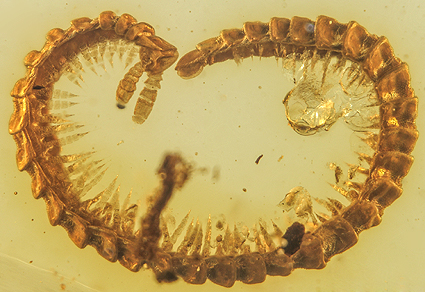Abstract
Two new species of the millipede family Siphonorhinidae, Siphonorhinus globosus sp. nov. and Siphonorhinus peculiaris sp. nov., are described from the mid-Cretaceous Burmese amber. Detailed morphological characters are provided on the basis of 22 specimens, mainly using confocal laser scanning microscopy. The new species can be confidently placed in the extant genus Siphonorhinus based on the head lacking a beak-like rostrum, antennae stout and elbowed; antennomeres 5 and 6 each with a field of basiconic sensilla, and gonopods leg-like, with apical podomere of posterior gonopod divided to two branches. A detailed comparison between the new and extant species is given.
References
- Attems, C.M.T. (1930) Myriopoden der Kleinen Sunda-Inseln, gesammelt von der Expedition Dr. Rensch. Mitteilungen aus dem Zoologischen Museum in Berlin, 16 (1), 117–184. https://doi.org/10.1002/mmnz.19300160103
- Attems, C.M.T. (1936) Diplopoda of India. Memoirs of the Indian Museum, 11 (4), 133–323.
- Attems, C.M.T. (1938) Die von Dr. C. Dawydoff in französisch Indochina gesammelten Myriopoden. Mémoires du Muséum national d'histoire naturelle, N. S., 6 (2), 187–353.
- Azar, D., Perrichot, V., Néraudeau, D. & Nel, A. (2003) New psychodid flies from the Cretaceous ambers of Lebanon and France, with a discussion about Eophlebotomus connectens Cockerell, 1920 (Diptera, Psychodidae). Annals of the Entomological Society of America, 96, 117–127.
- https://doi.org/10.1603/0013-8746(2003)096[0117:NPFTCA]2.0.CO;2
- Cai, C.Y. & Huang, D.Y. (2014) The oldest micropepline beetle from Cretaceous Burmese amber and its phylogenetic implications (Coleoptera: Staphylinidae). Naturwissenschaften, 101, 813–817. https://doi.org/10.1007/s00114-014-1221-z
- Cruickshank, R.D. & Ko, K. (2003) Geology of an amber locality in the Hukawng Valley, northern Myanmar. Journal of Asian Earth Sciences, 21, 441–455.
- https://doi.org/10.1016/S1367-9120(02)00044-5
- Enghoff, H., Golovatch, S.I., Short, M., Stoev, O. & Wesener, T. (2015) Diplopoda—taxonomic overview. In: Minelli, A. (Ed.), Treatise on Zoology—Anatomy, taxonomy, biology. The Myriapoda. Volume 2. Brill, Leiden and Boston, pp. 363–453. https://doi.org/10.1163/9789004188273_017
- Fu, Y.Z., Li, Y.D., Su, Y.T., Cai, C.Y. & Huang, D.Y. (2021) Application of confocal laser scanning microscopy to the study of amber bioinclusions. Palaeoentomology, 4 (3), 266–278. https://doi.org/10.11646/palaeoentomology.4.3.14
- Grimaldi, D.A., Engel, M.S. & Nascimbene, P.C. (2002) Fossiliferous Cretaceous amber from Myanmar (Burma): its rediscovery, biotic diversity, and paleontological significance. American Museum Novitates, 3361, 1–71. https://doi.org/10.1206/0003-0082(2002)361<0001:FCAFMB>2.0.CO;2
- Jiang, X.K., Shear, W.A., Hennen, D.A., Chen, H.M. & Xie, Z.C. (2019) One hundred million years of stasis: Siphonophora hui sp. nov. the first Mesozoic sucking millipede (Diplopoda: Siphonophorida) from mid-Cretaceous Burmese amber. Cretaceous Research, 97, 34–39. https://doi.org/10.1016/j.cretres.2019.01.011
- Li, Y.D., Ślipiński, A., Huang, D.Y. & Cai, C.Y. (2023) New fossils of Sphaeriusidae from mid-Cretaceous Burmese amber revealed by confocal microscopy (Coleoptera: Myxophaga). Frontiers in Earth Science, 10, 901573. https://doi.org/10.3389/feart.2022.901573
- Mao, Y.Y., Liang, K., Su, Y.T., Li, J.G., Rao, X., Zhang, H., Xia, F.Y., Fu, Y.Z., Cai, C.Y. & Huang, D.Y. (2018) Various amberground marine animals on Burmese amber with discussions on its age. Palaeoentomology, 1 (1), 91–103. https://doi.org/10.11646/palaeoentomology.1.1.11
- Marek, P.E., Shear, W. A. & Bond, J.E. (2012) A redescription of the leggiest animal, the millipede Illacme plenipes, with notes on its natural history and biogeography (Diplopoda, Siphonophorida, Siphonorhinidae). ZooKeys, 241, 77–112. https://doi.org/10.3897/zookeys.241.3831
- Marek, P.E., Buzatto, B.A., Shear, W.A., Means, J.C., Black, D.G., Harvey, M.S. & Rodriguez, J. (2021) The first true millipede—1306 legs long. Scientific Reports, 11, 23126. https://doi.org/10.1038/s41598-021-02447-0
- Moritz, L. & Parra-Gómez A. (2023) Notorhinus floresi sp. nov. gen. nov.: The first records of Siphonophorida in Chile and Siphonorhinidae in South America (Colobognatha). Arthropod Systematics & Phylogeny, 81, 565–579. https://doi.org/10.3897/asp.81.e100520
- Pocock, R.I. (1894) Chilopoda, Symphyla and Diplopoda from the Malay Archipelago. In: Weber, M. (Ed.), Zoologische Ergebnisse einer Reise in Niederländisch Ost-Indien. Vol. 3. E.J. Brill, Leiden, pp. 307–404.
- Read, H.J. & Enghoff, H. (2009) The order Siphonophorida—A taxonomist’s nightmare? Lessons from a Brazilian collection. Soil Organisms, 81(3): 543–556.
- Ross, A.J. (2019) Burmese (Myanmar) amber checklist and bibliography 2018. Palaeoentomology, 2 (1), 22–84. https://doi.org/10.11646/palaeoentomology.2.1.5
- Ross, A.J. (2021) Supplement to the Burmese (Myanmar) amber checklist and bibliography, 2020. Palaeoentomology, 4 (1), 57–76. https://doi.org/10.11646/palaeoentomology.4.1.11
- Ross, A.J. (2023) Supplement to the Burmese (Myanmar) amber checklist and bibliography, 2022. Palaeoentomology, 6 (1), 22–40. https://doi.org/10.11646/palaeoentomology.6.1.6
- Ross, A.J., Mellish, C., York, P. & Crighton, B. (2010) Burmese amber. In: Penney, D. (Ed.), Biodiversity of fossils in amber from the major world deposits. Siri Scientific Press, Manchester, pp. 208–235.
- Shi, G.H., Grimaldi, D.A., Harlow, G.E., Wang, J., Wang, J., Yang, M.C., Lei, W.Y., Li, Q.L. & Li, X.H. (2012) Age constraint on Burmese amber based on U-Pb dating of zircons. Cretaceous Research, 37, 155–163. https://doi.org/10.1016/j.cretres.2012.03.014
- Sierwald, P. & Spelda, J. (2023) MilliBase. Siphonorhinidae Cook, 1895. Available from: https://www.millibase.org/aphia.php?p=taxdetails&id=888781 (Accessed 2024-1-28).
- Silvestri F. (1895) I Chilopodi ed i Diplopodi di Sumatra e delle isole Nias, Engano e Mentavei. Annali del Museo civico di storia naturale di Genova, 2 (14), 707–760.
- Su, Y.T., Cai, C.Y. & Huang, D.Y. (2021) Morphological revision of Siphonophora hui (Myriapoda: Diplopoda: Siphonophoridae) from the mid-Cretaceous Burmese amber. Palaeoentomology, 4 (3), 279–288. https://doi.org/10.11646/palaeoentomology.4.3.15
- Su, Y.T., Cai, C.Y. & Huang, D.Y. (2022) A new species of Trichopolydesmidae (Myriapoda, Diplopoda, Polydesmida) from the mid-Cretaceous Burmese amber. Palaeoentomology, 5 (6), 606–622. https://doi.org/10.11646/palaeoentomology.5.6.10
- Su, Y.T., Cai, C.Y. & Huang, D.Y. (2023) A new species of Polydesmidae (Myriapoda, Diplopoda, Polydesmida) from the mid-Cretaceous Burmese amber. Zootaxa, 5396 (1), 112–123. https://doi.org/10.11646/zootaxa.5396.1.16
- Turk F.A. (1948) On a collection of diplopods from North India, both cavernicolous and epigean. Proceedings of the Zoological Society of London, 117, 65–78. https://doi.org/10.1111/j.1096-3642.1947.tb00498.x
- Wesener T. (2023) Madagascarhinus, a new genus of the family Siphonorhinidae with two new species from Madagascar (Diplopoda, Siphonophorida). Zootaxa, 5278 (1), 163–175. https://doi.org/10.11646/zootaxa.5278.1.9
- Wesener, T. & Moritz, L. (2018) Checklist of the Myriapoda in Cretaceous Burmese amber and a correction of the Myriapoda identified by Zhang (2017). Check List, 14 (6), 1131–1140. https://doi.org/10.15560/14.6.1131
- Yin, Z.W., Cai, C.Y. & Huang, D.Y. (2018) Last major gap in scydmaenine evolution filled (Coleoptera: Staphylinidae). Cretaceous Research, 84, 62–68. https://doi.org/10.1016/j.cretres.2017.10.026
- Zherikhin, V.V. & Ross, A.J. (2000) A review of the history, geology and age of Burmese amber (Burmite). Bulletin of the Natural History Museum, London (Geology), 56, 3–10.


